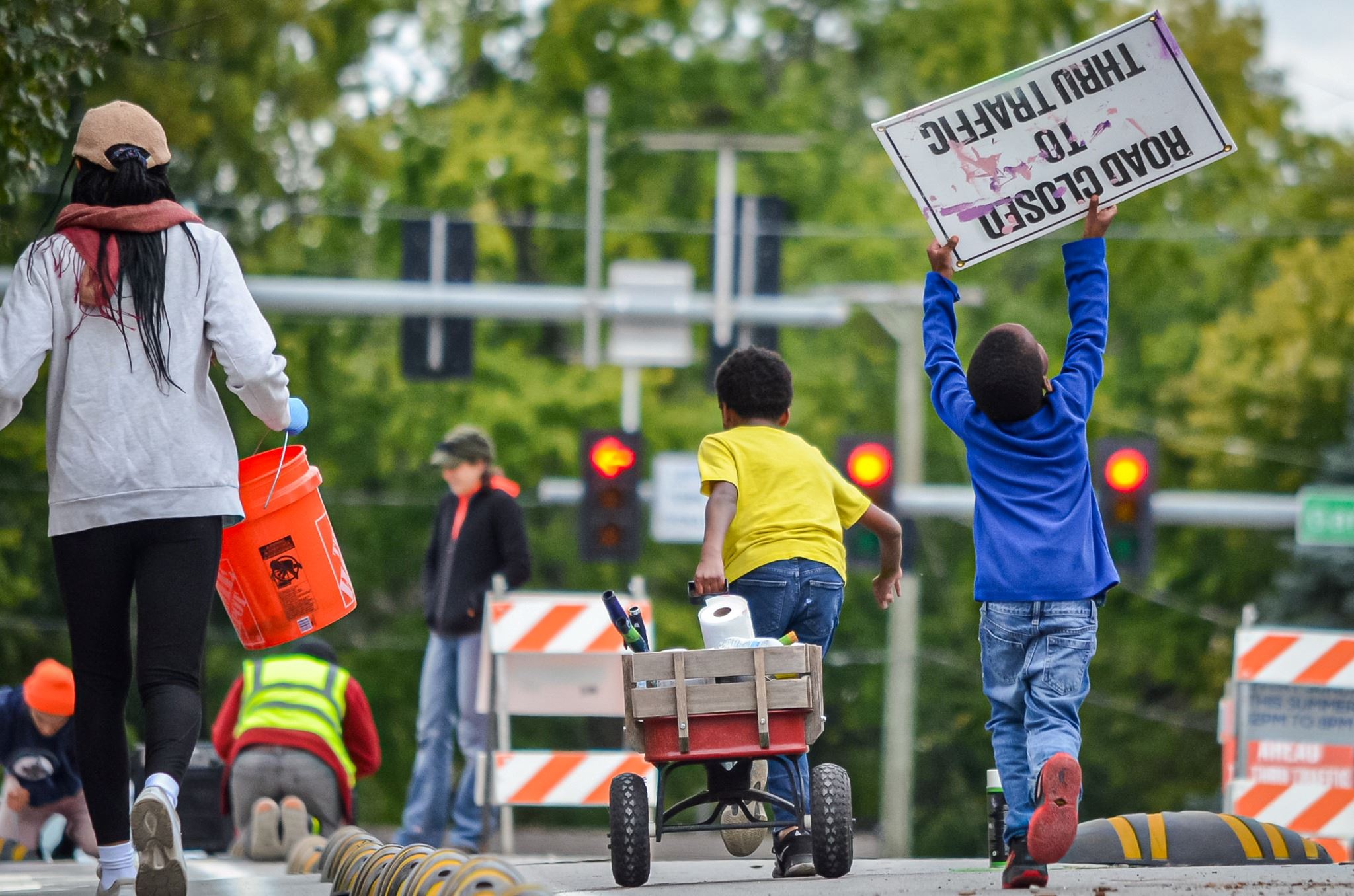Quick-build projects prioritize affordable, rapid, and temporary solutions to inaccessible and unsafe streetscape conditions. Through this approach to project implementation, communities are able to set an example that establishes the need and precedent for continued change in their urban environment.

What are quick builds?
Smart Growth America has a variety of resources on how quick builds develop and what they can achieve. Access them here.
In recent years, the practice of installing rapid, low-cost, and temporary improvements to public space has gained popularity. These initiatives, often called “tactical urbanism” or “quick builds” emphasize action, prioritizing short-term projects designed to improve street safety, public spaces, and enjoyability of the streetscape for all users.
There are many groups around the country utilizing quick builds in their communities, and all share a common goal of using low-cost materials to experiment with and gather input on potential design changes. While quick builds can create impressive changes to spaces, their real power lies in illustrating what works, what doesn’t, and what our urban spaces should look like.
Quick-build projects may look and work very differently depending upon the community’s needs; however, the approach remains similar. These initiatives work in the gray area, opting to avoid bureaucratic processes or expensive materials which delay changes to public spaces. They’re especially useful when a community needs to inspire action because it draws attention to perceived shortcomings, widens public engagement, deepens understanding, gathers data, encourages people to work together, and tests solutions.
Smart Growth America has been integrating quick builds into their Complete Streets initiatives through technical assistance projects across the country, testing new street designs and innovating best practices. In November 2022, Smart Growth America launched their most recent Complete Streets Leadership Academy (CSLA), a series of virtual sessions and in-person workshops designed to support community-led quick-build projects on state-owned roads. One of the goals of these projects was to strengthen relationships between state DOTs and local jurisdictions to help pave the way for further change.
Mike Lydon and Anthony Garcia’s book, Tactical Urbanism: Short-term Action for Long-term Change, illustrates examples of how the approach can be utilized and includes a toolkit to guide project planning and implementation. According to the guide, any initiative utilizing Tactical Urbanism should consist of three main principles: safety enhancement, ability to adapt across project implementation, and constant innovation.

Small actions lead to big changes across the nation
Projects like quick builds have been utilized to make significant changes to urban spaces since the early 2000s. Former New York City Department of Transportation Commissioner, Janette Sadik-Khan, has stated that a rapid quick-build-style approach was key to her work in New York City from 2007-2013. Sadik-Khan’s initiatives during the time included the implementation of 400 bike lanes, the launch of CitiBike, the building of 60 pedestrian plazas, and, most notably, the closure of car access on Broadway through Times Square.
The projects utilized quick-build approaches such as rapid implementation and the use of impermanent materials, and with support from leadership and funding to back them up, the eventual development of these initiatives into permanent structures points to quick build projects’ ability to push design changes across the finish line. The precedent set by Sadik-Khan has changed the way the country thinks about transportation, an impact we can see across the nation as multi-modal transportation initiatives expand.
With innovation and adaptation as key principles in these temporary and low-cost projects, it’s no surprise that the advocacy strategies for the approach have evolved over time. One example of this is the work of Vignesh Swaminathan, known on TikTok as Mr. Barricade. Not only have his short social media videos inspired and educated people around the world, but his work as a consultant put more quick builds into practice.
In 2019, Swaminathan worked with the City of San Jose, California to lay ten-miles of temporary protected bike lanes. Swaminathan helped the city save on the installation by coordinating lane installations with planned repavings and the use of plastic vertical bollards and bus stop islands. The city eventually plans to replace the plastic barriers with concrete islands, making the lanes permanent.

Shaping progress with community engagement
Some government leaders are using temporary, low-cost projects to put power into people’s hands. In Fayetteville, Arkansas, the city government has created an online application for citizens to gain approval for projects which will ultimately influence the city’s planning and development. The city has also developed a guide to community-led tactical urbanism which helps residents plan and implement projects. If government entities want to have an impactful role in urban infrastructure evolution, they can’t act alone—these processes require mutual trust, community buy-in, and participatory community feedback.
When government officials, practitioners, and community members come together to reap the benefits of quick builds, the practice can bring multimodal streetscapes to life. This provides an opportunity to test the effectiveness and popularity of design changes. Quick builds offer a mechanism to make small short-term safety improvements again and again, teaching us how to make our streets safer in the long term, too.
The post “Short-term action, long-term change”: How quick builds are bringing innovation to safe streets implementation appeared first on Transportation For America.











